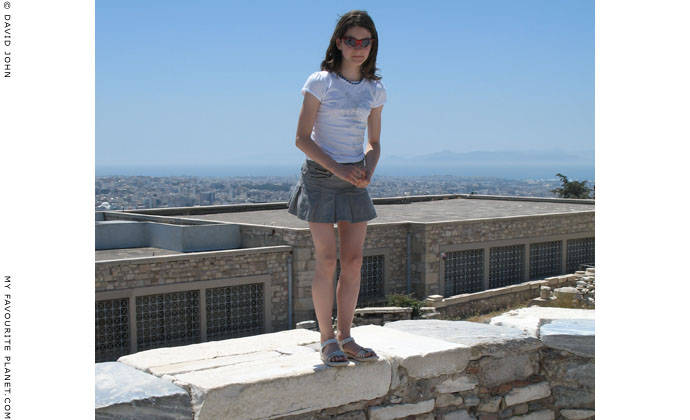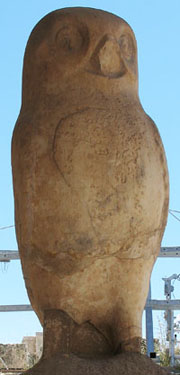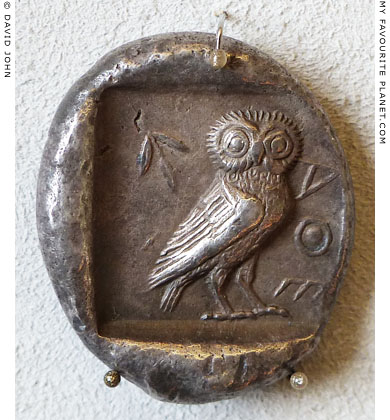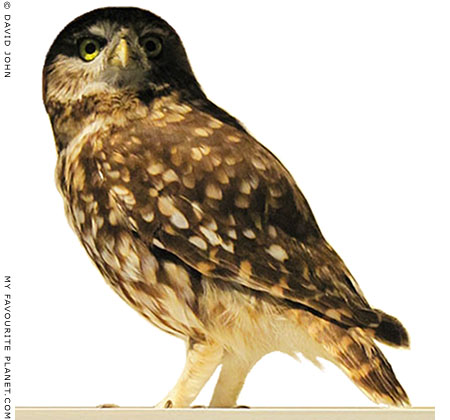|
|
|
| My Favourite Planet > English > Europe > Greece > Attica > Athens > galleries > Acropolis |
|
| |

On top of the world. |
In the background is the Old Acropolis Museum (1874-2007, see photos below) on the southern edge of the Acropolis. The stone-clad building, consisting of low-rise rectangular blocks with flat roofs, stands just to the south of the Parthenon, on a level below the ancient buildings of the Acropolis plateau, and was accessed by a flight of steps down to a small forecourt. It is thus very unobtrusive, and hardly visible from the streets below or from on the plateau itself. The entrance to the museum was guarded by a large ancient marble statue of an owl (see below).
Designed by architect Panages Kalkos, the old museum was built 1865-1874 to house the enormous number of archaeological finds which had been unearthed from among the ruins on the Acropolis.
Despite being redesigned and expanded in the 1950s, towards the end of the 20th century the museum was considered far too small for the ever-increasing number of visitors and newly-discovered artefacts, and too old fashioned to cope with modern concepts of museum usage, such as accessibility (particularly for disabled visitors), interactive electronic information systems, as well as more effective lighting, environmental control and security.
It was closed in June 2007, and all the exhibits - including the owl - were moved to the New Acropolis Museum, on Areopagitou Street [1], beneath the south side of the rock, which was officially opened in June 2009.
Although it could get quite cramped in the old museum, it had been built on a very modest, human scale. Visitors could get quite close to the exhibits and see intricate details of ancient arts and crafts. The museum staff had done a wonderful job with the available space and some unobtrusive lighting, so that the atmosphere was quite relaxed, even intimate, in the style of some of the provincial Greek museums, such as at Thessaloniki, Amphipolis, Samos, Thasos or Heraklion, Crete, in contrast to the monumentality of the National Archaeological Museum in central Athens.
The contrast between the old-fashioned homeliness of the old museum and the overwhelmingly vast, cool, modern spaces of the new museum could not be starker. The old museum was in its day seen as the best solution to the problem of how to publicly present the ancient artworks on the Acropolis without intruding on the assemblage of Classical ruins which had been recreated on the rock (a concept which demanded the controversial eradication of all more recent buildings). In the enormous new museum, one gets the impression that it is the building itself which is the main attraction; the artefacts and the visitors seem dwarfed by the space.
We plan to include more information about New Acropolis Museum in the near future.
The Acropolis Museum Owl
"Colossal owl" (Greek, Κολοσσιαία γλαύκη).
Archaic, dated to early the 5th century BC. Parian marble, height 91 cm, width 40 cm, depth 55 cm. [2]
Now in the front of the entrance to the New Acropolis Museum, Athens. Inv. No. Acr. 1347.
The Archaic owl is among the oldest surviving free-standing sculptures from the Acropolis. Found about 1838 in association with two monolithic votive columns, near the precinct of Brauronian Artemis, on the southeastern side of the Propylaia (see plan of the Propylaia on gallery page 10).
It is thought that it stood on one of these columns as a votive offering to Athena, whose symbol as the goddess of wisdom was the owl. The ancient Greek name for owl was glaukos (γλαῦκος) which means glaring or shining (eyes). This species of owl, known as the glaux, Little Owl and Athene noctua (see photo below), still lives around the Acropolis. One of Athena's epithets was Glaukopi (translated as bright or shining eyed, or owl-faced).
The German archaeologist Ludwig Ross (see gallery page 12) believed that the owl may have been fixed onto one of the columns dedicated by Timotheos of Anaphlystos. (Ross, Annali, 1841, page 25 and plate B; Archäologische Aufsätze, Erste Sammlung I, page 205 and plate XIV.)
A 6th century BC Panathenaic vase (a type of amphora which held the sacred olive oil awarded as a prize to winners of athletic contests during the Panathenaic festival in honour of Athena) clearly shows a helmeted Athena, with raised spear and shield, flanked by two owls on tall columns. (See: John McK. Camp II, Gods and heroes in the Athenian Agora, page 6. American School of Classical Studies at Athens, 1980.)
Fragments of another two owl sculptures of Hymettian marble have also been found on the Acropolis.
|

The marble owl which
used to stand outside
the Old Acropolis Museum.
Around 500-480 BC.
Acropolis Museum, Athens.
Inv. No. Acr. 1347.
See below. |
| |

Detail of the "Piraeus
Athena" bronze statue,
circa 340-330 BC, with
an owl on each of the
cheek coverings of her
Corinthian helmet.
Piraeus Archaeological
Museum. Inv. No. 4646. |
| |
| |

An Athenian silver tetradrachm, minted around 500 BC,
in the same period as the creation of the owl statue.
The reverse side shows Athena's olive branch, her sacred owl
and the letters "ΑΘΕ" for Athinai. The obverse shows the head
of Athena in profile, wearing a helmet. Athenian tetradrachms
were known as "owls", and the bird appeared on the city's
coinage from the 6th to the 1st century BC.
Numismatic Collection, Bode Museum, Berlin. |
| |

Limestone owl made as a votive offering to Athena. From Athens.
Altes Museum, Berlin. Acquired 1912. Inv. No. SK 1722. |
| |

An Athene noctua, or Little Owl. |
| |

A relief of Athena / Minerva and her owl on a gold-plated silver plate. 2nd century BC.
|
The relief shows Athena, or her Roman equivalent Minerva, seated and wearing the triple-crested helmet known from the famous 5th century BC colossal statue of Athena Parthenos by Pheidias, which stood in the Parthenon. Around her left shoulder and breast she wears the aeigis, and in her left arm she holds a shield on which is the head of the Gorgon Medusa. The tiny owl stands to her right on a high rocky pinnacle draped with a victory wreath.
For more information about Athena's aegis and the Gorgon Medusa, see Pergamon gallery 2, page 13.
It is thought that the relief was made in the 2nd century BC, and added to the plate during the time of the Emperor Augustus (63 BC-14 AD).
The plate is part of a hoard of Roman tableware of the 1st century BC - 1st century AD, known as the "Hildesheim silver treasure", discovered in 1868 in Hildesheim, Germany, and now in the Altes Museum, Berlin.
The luxurious dinner service, consists of over 70 pieces of exquisitely decorated silver, gold-plated and niello dining and drinking vessels, two mirrors and a table. The pieces, produced at various dates and locations, appear to have been the property of a collector, but it is not known how they ended up in the area of Hildesheim which was beyond the borders of Roman-occupied Germania.
Altes Museum, Berlin. Inv. No. Misc. 3779, 1-73. |
|

Athena's owl |
|
| |
The Old
Acropolis
Museum |
Notes, references and links |
 |
|
1. Areopagitou Street
Odos Dionysiou Areopagitou (Οδός Διονυσίου Αρεοπαγίτου; Οδός = street) runs from Amalias Avenue (Leoforos Vas. Amalias, which starts at the top of Syntagma Square), just opposite the Temple of Olympian Zeus and Hadrian's Arch in the east, along the valley between the Acropols Hill (to the north) and Philopappou Hill (to the south). It then veers northwest and becomes Odos Apostolou Pavlou (Οδός Αποστόλου Παύλου, Apostle Paul Street) and heads downhill past the Pnyx and the Observatory (left) and the Ancient Agora (right) to the Thission district (old houses, trendy bars and restaurants).
It used to be a noisy, traffic-clogged road joining central Athens to the western suburbs, lined with tourist-trap shops and restaurants (one neon sign advertised "air-conditioned pizza"). It has now been pedestrianized, tamed and culturally sanitized, allowing Athenians and visitors the freedom to walk around these fascinating areas.
The footpath up to the entrance of the Acropolis itself is to the right, about 800 metres along Areopagitou Street as you walk westwards from Hadrian's Arch.
Various other footpaths lead off from Areopagitou Street and Apostolou Pavlou street, south up to the Philopappou Monument, Pnyx and Observatory, and north to the Ancient Agora. You may also find the narrow streets, old houses and tavernas of the Makrigiani neighbourhood, immediately south of Areopagitou Street, worth exploring. |
|
|
2. The Acropolis Museum Owl
See:
Stanley Casson (1889-1944), Catalogue of the Acropolis Museum, Volume II: Sculpture and architectural fragments, with a section upon the terracottas. Pages 30 and 252-253. Cambridge University Press, 1921. At archive.org
Ismini Trianti, The Acropolis Museum, page 207, photos on pages 212-213. Eurobank / Latsis Group. Published by OLKOS, Athens, 1998.
E-book in English and Greek.
Although Casson's Catalogue of the Acropolis Museum states that the owl was made of Pentelic marble (from Mount Pendeli, Athens), according to The Acropolis Museum book the stone came from the island of Paros.
The Acropolis Museum book actually deals with the Old Acropolis Museum, and in this sense is already outdated. However, the bulk of the book features historically contextualized descriptions and excellent photos of the exhibits, which have remained unchanged.
This volume is part of the excellent series, "The Museums Cycle", produced the John S. Latsis Public Benefit Foundation. The large, lavishly illustrated tomes are excellent guides to some of Greece's finest museums. However, they are very heavy: the book about Pella (the best book about the place that I have seen anywhere), for example, weighs 3.5 kg. This means that visitors are hardly likely to want to lug them around museums or archaeological sites. Buying one of these guides while you are on holiday may also put a strain on your airline baggage allowance.
I bought so many books on my last visit to Athens that I thought I would mail them home. However, when the post office told me it would cost 80 Euros to send 8 kg of books across Europe (10 Euros per kilogram! And no more reduced rates for printed matter), I realized it would be cheaper to pay the 30 Euro excess baggage charge at the airport.
I have not yet seen one of these books for sale, so it is wonderful that the Latsis Group have provided their electronic library, so that we can read them online as e-books. |
|

A photo of the Acropolis owl
from Catalogue of the
Acropolis Museum
Volume II, 1921. |
|
| |

The Old Acropolis Museum, just before its closure in 2007. |
| |

Archaic kore statues in the Old Acropolis Museum, May 2007. |
Photos, illustrations, maps and articles: © David John,
except where otherwise specified.
Additional photos: © Konstanze Gundudis
All photos and articles are copyright protected.
Images and materials by other authors
have been attributed where applicable.
Please do not use these photos or articles without permission.
If you are interested in using any of the photos for your website,
project or publication, please get in contact.
Higher resolution versions are available on request.
My Favourite Planet makes great efforts to provide comprehensive and accurate information across this website. However, we can take no responsibility for inaccuracies or changes made by providers of services mentioned on these pages. |
|
| |
 |
Visit the My Favourite Planet Group on Facebook.
Join the group, write a message or comment,
post photos and videos, start a discussion... |
|
|
| |
|
|
| |
| |
 |
| |
 |
| |
 |
| |
 |
| |
 |
| |
 |
| |
George Alvanos
rooms in
Kavala's historic Panagia District
Anthemiou 35,
Kavala, Greece
kavalarooms.gr
|
| |
Olive Garden Restaurant
Kastellorizo,
Greece
+30 22460 49 109
kastellorizo.de
|
| |
Papoutsis
Travel Agency
Kastellorizo,
Greece
+30 22460 49 286
greeklodgings.gr
|
| |
|